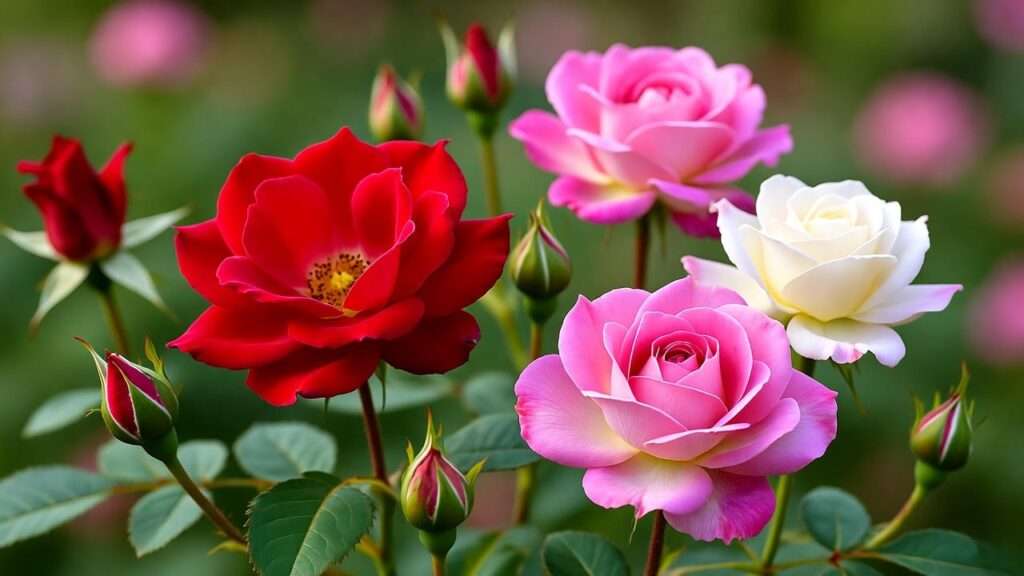There is a unique type of gardener’s heartbreak: the moment you spot a perfect, emerging rosebud only to discover its leaves are speckled with tell-tale black spots or swarming with tiny green pests. Roses, the undisputed queens of the garden, are notoriously susceptible to a wide range of diseases and insects. If you’ve ever felt defeated by the constant battle against mildew or mites, you are not alone.
The good news is that achieving those picture-perfect, healthy blooms isn’t about luck—it’s about adopting a strategic defense. The secret lies not in endlessly blasting your plants with chemicals, but in precision, timing, and selecting the absolute best $\text{rose plant spray}$ for the job. Within the first 100 words of this guide, we establish a core truth: the correct spray, applied at the right time, is the single most crucial tool in your toolkit.
As certified plant experts with decades of experience in hybridizing and cultivation, we’ve developed this ultimate guide to cut through the noise. We will provide proven, season-long strategies for managing pests and diseases, ensuring your roses are vibrant, robust, and resilient. Our focus is on knowledge and precision—the cornerstones of lasting rose health. You don’t need harsh, indiscriminate treatments; you need targeted action based on authoritative expertise.
II. 🔍 Diagnosis First: Identifying the Enemy Before You Spray
Expert Insight: The most common mistake amateur rose growers make is applying a generic product without first confirming the problem. Spraying without proper identification is wasteful, harms beneficial insects, and allows the actual issue to escalate.
Before reaching for any bottle, you must become a plant detective. Different problems require entirely different solutions. A fungicide won’t stop an insect, and a basic horticultural oil may not halt a severe case of fungal rust.
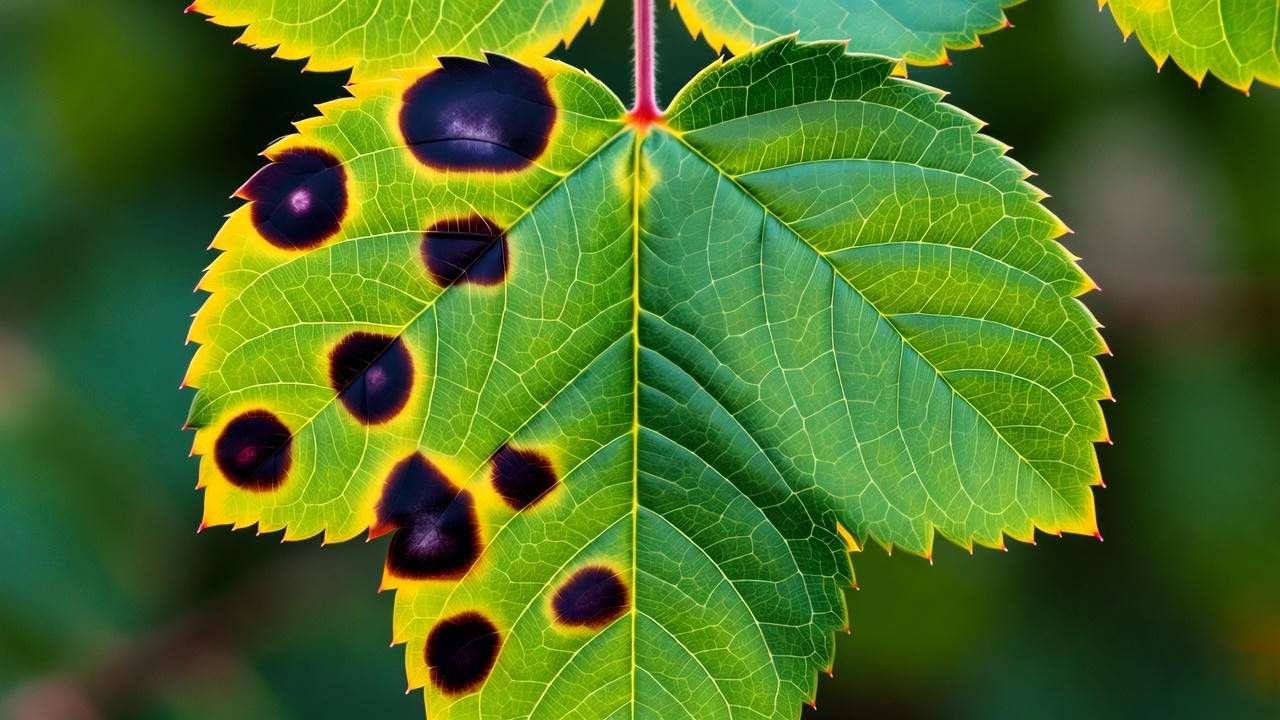
A. The Most Common Fungal Diseases (H3)
Fungal pathogens thrive in damp, warm conditions, making them the most prevalent threat to roses.
- Black Spot ($\text{Diplocarpon rosae}$): 🖤 This is the arch-nemesis of many rose varieties. Black spot manifests as circular, dark black lesions, usually on the upper surface of the leaves. Infected leaves often turn bright yellow around the spots before falling off the plant entirely, leading to defoliation.
- Need/Solution: Requires a systemic fungicide (which is absorbed and moves within the plant) or a protective fungicide (which coats the leaves and prevents spore germination). Sanitation is critical.
- Powdery Mildew: 👻 Unlike Black Spot, Powdery Mildew prefers mild, dry days and cool, humid nights. It appears as a dusty, white or grayish coating on leaves, buds, and young stems, often causing the new growth to look distorted, curled, or stunted.
- Need/Solution: Requires specific fungicides or the use of baking soda/oil solutions which alter the leaf surface pH, making it hostile to the fungus. Horticultural oils are highly effective for minor cases.
- Rust: 🟠 While less common than black spot, rose rust is easily identifiable by its powdery, rusty-orange pustules that form almost exclusively on the undersides of the leaves. If left untreated, the entire plant can become weak and defoliate.
- Need/Solution: Focus heavily on sanitation and using specific copper-based sprays or sulfur products, which are known to suppress rust spores.
B. The Top Destructive Rose Pests (H3)
Insect pests damage roses by sucking sap, chewing tissue, or causing deformities.
- Aphids: 🟢 These small, soft-bodied, pear-shaped insects cluster in large colonies on the tender new growth, stems, and flower buds. They feed by sucking plant juices, which causes stunted, sticky, or distorted growth (known as “honeydew”). They reproduce incredibly fast.
- Need/Solution: Insecticidal soaps, horticultural oils, or a strong blast of water are usually effective. For severe infestations, targeted contact sprays are necessary.
- Spider Mites: 🕸️ These are technically arachnids, not insects, and they thrive in hot, dry conditions. They are nearly invisible to the naked eye. Their presence is indicated by fine, silky webbing around buds and leaf joints, and by leaves developing a silvery or bronze stippling (tiny pinpricks) appearance.
- Need/Solution: They are resistant to many conventional insecticides. The best defense is a strong water jet aimed at the underside of the leaves, or the application of horticultural oils or specialized miticides.
- Thrips: 💨 Thrips are tiny, slender insects that damage flower petals and new foliage, often causing blooms to turn brown on the edges or fail to open properly (“balling”). They are notorious for being difficult to spot until the damage is done.
- Need/Solution: Control is challenging and often requires systemic products or highly effective contact insecticides applied repeatedly to interrupt their life cycle.
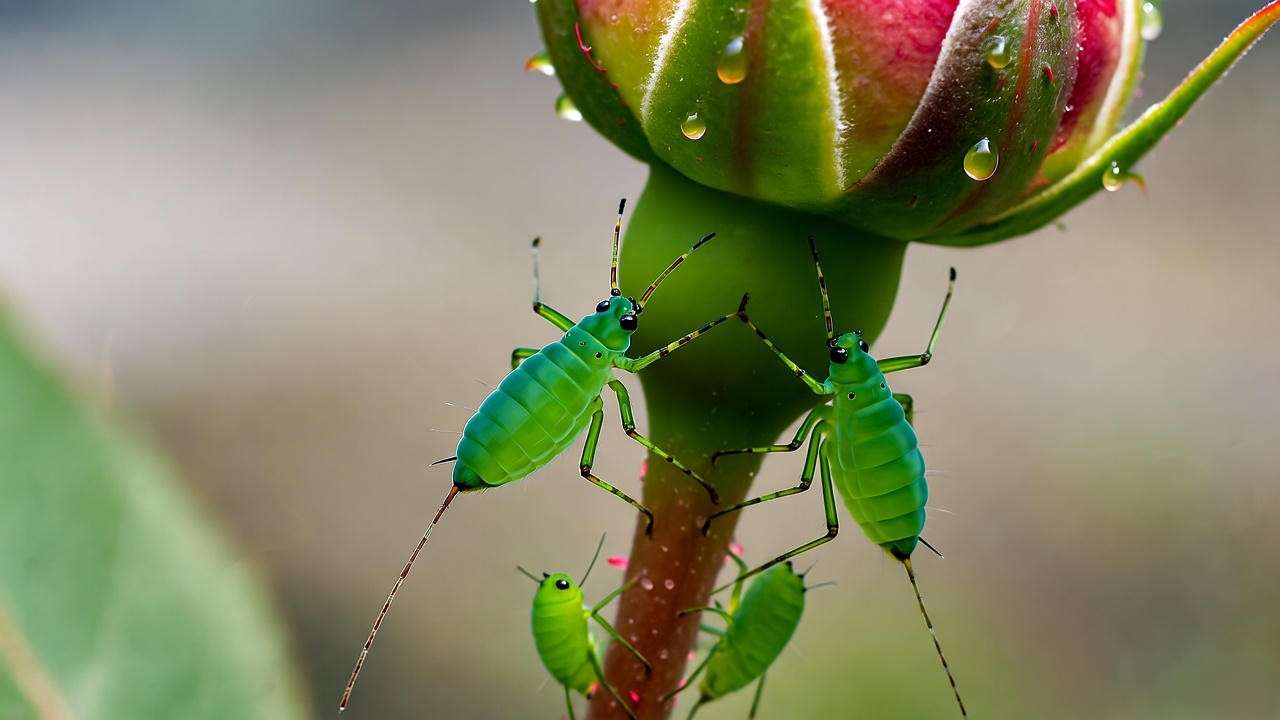
III. 🌿 Choosing Your Weapon: The Two Main Types of $\text{Rose Plant Spray}$ (H2)
The battle plan starts with selecting the right product. The choice between organic and synthetic often comes down to personal philosophy, but both require a keen understanding of their modes of action.
A. Organic and Low-Impact Sprays (H3)
These solutions are favored by eco-conscious gardeners for their low environmental persistence and reduced risk to beneficial insects, though they often require more frequent application.
- Neem Oil: 💧 Derived from the seeds of the Neem tree, this is the gold standard for organic rose care. It acts as both a mild fungicide and a multifaceted insecticide (specifically a growth regulator and antifeedant).
- Best for: General prevention, early-stage powdery mildew, and control of soft-bodied pests like aphids and spider mites. Its active ingredient, azadirachtin, disrupts the insect life cycle.
- Application Tip: Always use an emulsifier (like a few drops of dish soap) and mix with water before application. Never apply concentrated neem oil.
- Insecticidal Soap (Potassium Salts of Fatty Acids): 🧼 This is a true contact killer. It works by disrupting the cell membranes of soft-bodied insects, causing them to dehydrate or suffocate. Its effectiveness is entirely reliant on physically covering the pest.
- Best for: Immediate knockdown of aphids, thrips, whiteflies, and scale insects. It has minimal residual effect, meaning it breaks down quickly and is safe for pollinators once dry.
- Horticultural Oils (Mineral or Vegetable-Based): ⛽ These petroleum- or plant-based oils suffocate insect eggs, larvae, and adults, and can also smother fungal spores.
- Key Distinction: Dormant oils are heavier and used on bare canes in late winter to kill overwintering pests, but must never be applied to actively growing foliage. Summer oils (or All-Season Oils) are highly refined and lighter, safe for use during the growing season, provided temperatures are moderate.
- DIY Home Remedies (The Expert’s View): 🧪 While many home recipes exist, few are as consistently effective and safe as commercial organic products. However, the Baking Soda Spray is an approved preventative solution for fungal issues like powdery mildew.
- Recipe: Mix 1 tablespoon of baking soda ($\text{sodium bicarbonate}$) with 1 tablespoon of horticultural oil and a few drops of mild soap per gallon of water.
- Caution: Emphasize that DIY solutions are preventative, not curative. The baking soda helps raise the pH of the leaf surface, inhibiting spore growth. The soap and oil help it stick. Avoid using this in large concentrations, as the sodium can build up and burn the foliage (phytotoxicity).
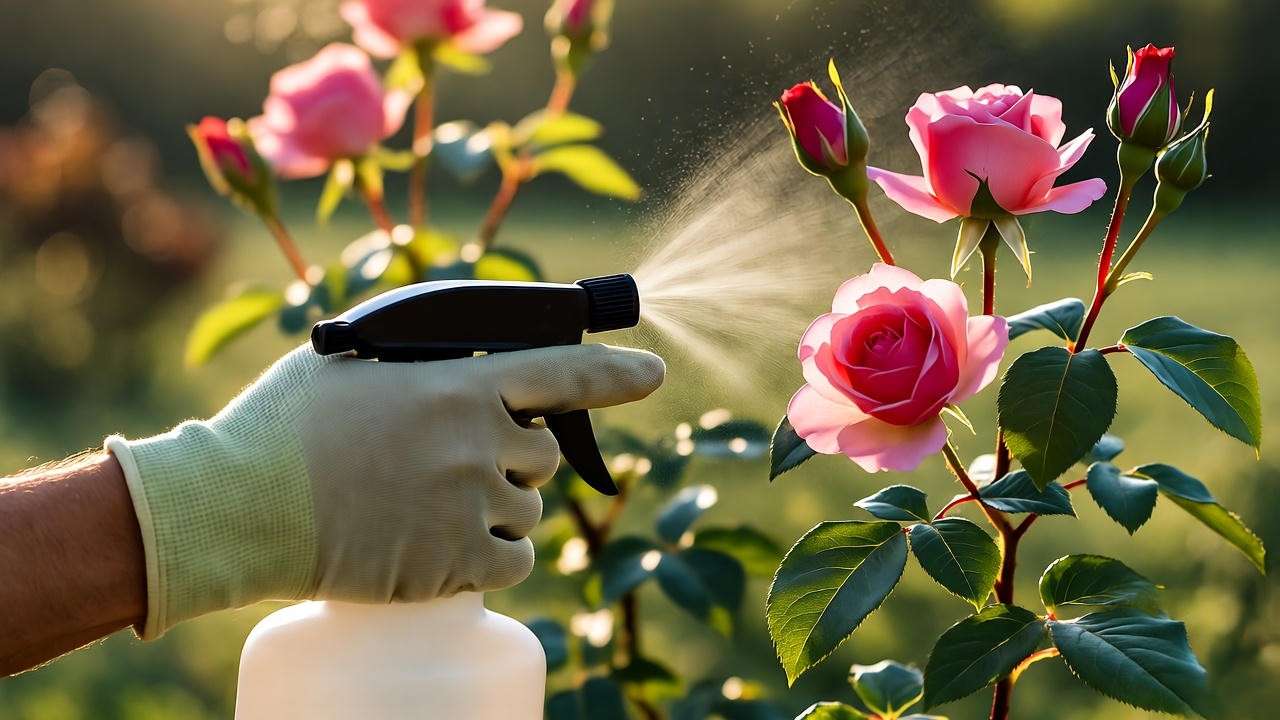
B. Conventional/Synthetic Systemic and Contact Sprays (H3)
Synthetic products offer fast, often more reliable curative power against established, severe infestations, but require strict adherence to safety and environmental precautions.
- Systemic Insecticides (e.g., Imidacloprid, Dinotefuran): 💊 These powerful chemical sprays are either applied to the soil (drench) or foliage, where they are absorbed by the plant and translocated through the vascular system. When a pest feeds on the plant, it ingests the toxin.
- Best for: Long-lasting control of difficult pests like thrips, borers, and severe aphid populations.
- Warning: Crucial discussion on pollinator safety: These chemicals, once in the plant, can be expressed in the pollen and nectar. Never apply systemic insecticides while the plant is actively blooming or during heavy pollinator activity. Use them only as a targeted pre-bloom treatment.
- Fungicides (Preventative vs. Curative): 🛡️ These are the heavy hitters against black spot and rust. They fall into two main categories:
- Protective (Contact): Ingredients like Chlorothalonil or Copper compounds coat the leaf surface and prevent fungal spores from germinating. They must be reapplied frequently.
- Curative (Systemic): Ingredients like Tebuconazole or Propiconazole are absorbed and can eradicate fungal infections already inside the leaf tissue.
- Best Practice: To prevent the fungi from developing spray resistance, you must alternate between two or more different chemical classes (products with different active ingredients) on a rotational schedule throughout the season.
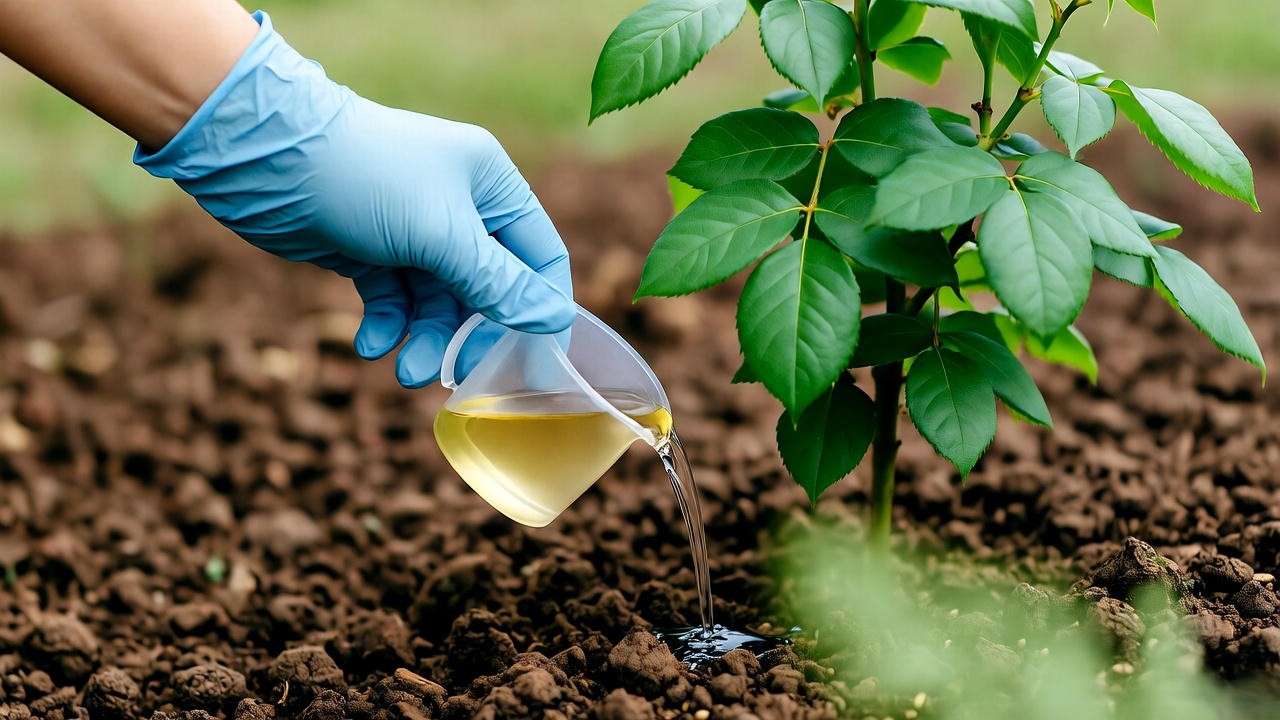
IV. 📅 The Spray Calendar: Timing is Everything
Effective disease and pest management on roses relies heavily on proactive timing, not reactive panic. A well-designed spray calendar is the foundation of a healthy rose garden, minimizing the opportunities for pathogens and pests to establish themselves.
A. Dormant Season (Late Winter/Early Spring) 😴
This is arguably the most critical and often-overlooked treatment window. The goal is to eliminate overwintering fungal spores (like Black Spot) and insect eggs (like Spider Mites) before they emerge.
- When to Apply: After the final annual pruning, just before the leaf buds begin to swell and break dormancy (typically late February to early March, depending on climate).
- The Go-To $\text{Rose Plant Spray}$: A combination of Dormant Oil and a Copper-based Fungicide. The oil suffocates the eggs and soft-bodied pests, while the copper provides a deep-cleaning antimicrobial treatment to the canes and surrounding soil.
B. Early Growing Season (Spring Flush) 🌷
Once new growth appears, the plant is vulnerable. Protective sprays must be applied before diseases appear.
- When to Apply: Start when the new shoots are about 4 to 6 inches long.
- The Strategy: Initiate your rotational fungicide schedule. If Black Spot or Powdery Mildew is an annual problem, begin with a protective fungicide (like Chlorothalonil) every 7 to 10 days, particularly in humid conditions. This is the time to apply systemic soil drenches for thrips or borers if you plan to use them, ensuring they are absorbed well before any buds start to open and attract pollinators.
C. The Active Growing Season (Spring through Fall) ☀️
This period requires constant vigilance, with treatment frequency driven by weather and plant health.
- Fungal Control: Continue spraying your rotational fungicide every 10 to 14 days, or immediately after a heavy rain if you are using contact-only products. Do not wait for symptoms. The goal of preventative fungicide is to keep the leaves clean.
- Pest Control (Integrated Pest Management – $\text{IPM}$): Adopt an $\text{IPM}$ approach. Only spray insecticides when pests are present. For minor aphid infestations, use a targeted Insecticidal Soap or Neem Oil application directly on the affected area. Avoid broad-spectrum sprays that kill beneficial insects like Ladybugs, which are natural controls for aphids.
D. Late Season (Fall Clean-Up) 🍂
Reducing the “inoculum” (the source of next year’s infection) is key to breaking the disease cycle.
- Action: Remove all infected and fallen leaves from around the plant and discard them (do not compost). After the roses drop their leaves, repeat the Dormant Oil and Copper Spray application. This sanitation practice is invaluable for long-term health.
V. 🧪 Application Best Practices: Safety and Efficacy
Applying a $\text{rose plant spray}$ effectively is a skill that separates the expert grower from the novice. Improper technique wastes product, can damage the plant (phytotoxicity), and creates unnecessary environmental risk.
A. The Golden Rules of Mixing and Application (H3)
- Read the Label (Mandatory E-E-A-T): This is non-negotiable. Every product label specifies the correct dilution rate, target pests, required protective equipment (PPE), and the crucial Re-Entry Interval (REI)—the time period after spraying during which people and pets should avoid the treated area.
- Water Quality: Use neutral or slightly acidic water. Hard water can reduce the effectiveness of some organic sprays like insecticidal soaps. If using powdered products, fully dissolve them in a small amount of warm water first before adding them to the main sprayer tank.
- Maximum Coverage: Always aim for 100% coverage, ensuring the spray drips slightly from the plant. This is especially vital for contact sprays. Focus meticulously on the undersides of the leaves and deep within the cane structure, as this is where fungal spores (Rust) and pests (Spider Mites) hide and breed.
B. Weather and Environmental Considerations (H3)
Selecting the right application window ensures both plant safety and product effectiveness.
- Temperature Rules: Never spray oils (Neem or Horticultural) when temperatures are above $\text{85}^\circ \text{F}$ ($\text{29}^\circ \text{C}$) or when the plant is water-stressed. High heat combined with oil can cause severe leaf burn (phytotoxicity). Aim for temperatures between $\text{45}^\circ \text{F}$ and $\text{80}^\circ \text{F}$.
- Sunlight: Spraying in bright, direct sunlight is a recipe for leaf burn. The optimal time for any application is early morning (before $\text{10}$ am) or late afternoon/evening (after $\text{4}$ pm), allowing the spray to dry before the strongest sun hits, or before heavy dew settles.
- Wind and Rain: A light, steady breeze is ideal for ensuring even application. Avoid spraying on windy days, as this leads to drift (wasting product and contaminating other areas). Do not spray when rain is imminent, as it will wash protective products away. Allow at least 6-12 hours for the spray to dry.
C. Safety First: Personal Protection (H3)
When handling concentrates and synthetic sprays, always wear appropriate Personal Protective Equipment (PPE): long sleeves, long pants, waterproof gloves, and eye protection. Dispose of unused chemicals according to local regulations; never dump them down the drain.
VI. 💡 Proactive Health: Beyond the $\text{Rose Plant Spray}$ (E-E-A-T Focus)
While sprays are essential curative and preventative tools, the truly experienced rose grower knows that the best defense is a strong offense—cultivating robust, healthy plants that naturally resist disease. This approach is called Integrated Pest Management ($\text{IPM}$).
A. Soil Health and Nutrition 🧪
A well-fed rose is a resilient rose. Focus on a balanced, nutrient-rich soil ecosystem.
- Fertilization: Roses are heavy feeders. Use a complete fertilizer (e.g., $\text{N-P-K}$ of $\text{10-10-10}$) specifically formulated for roses. Ensure they receive adequate secondary nutrients like magnesium and sulfur, which aid in general plant vigor and disease resistance.
- Mulching: Apply a 2-4 inch layer of organic mulch (shredded bark, compost) around the base of the plant. This prevents rain splash from carrying fungal spores (like Black Spot) from the soil up onto the lower leaves.
B. Pruning and Airflow ✂️
Proper pruning is an essential cultural practice that minimizes the need for a $\text{rose plant spray}$.
- Open Center: Always prune to create an open, vase-shaped center. This promotes excellent air circulation, which helps foliage dry faster after rain or watering. Moist, stagnant air is the biggest ally of Powdery Mildew and Black Spot.
- Sanitation Pruning: Immediately remove any canes or leaves showing signs of infection. When removing infected material, always dip your pruning shears in a disinfecting solution (a $\text{10\%}$ bleach solution or $\text{70\%}$ rubbing alcohol) between cuts to avoid spreading the disease.
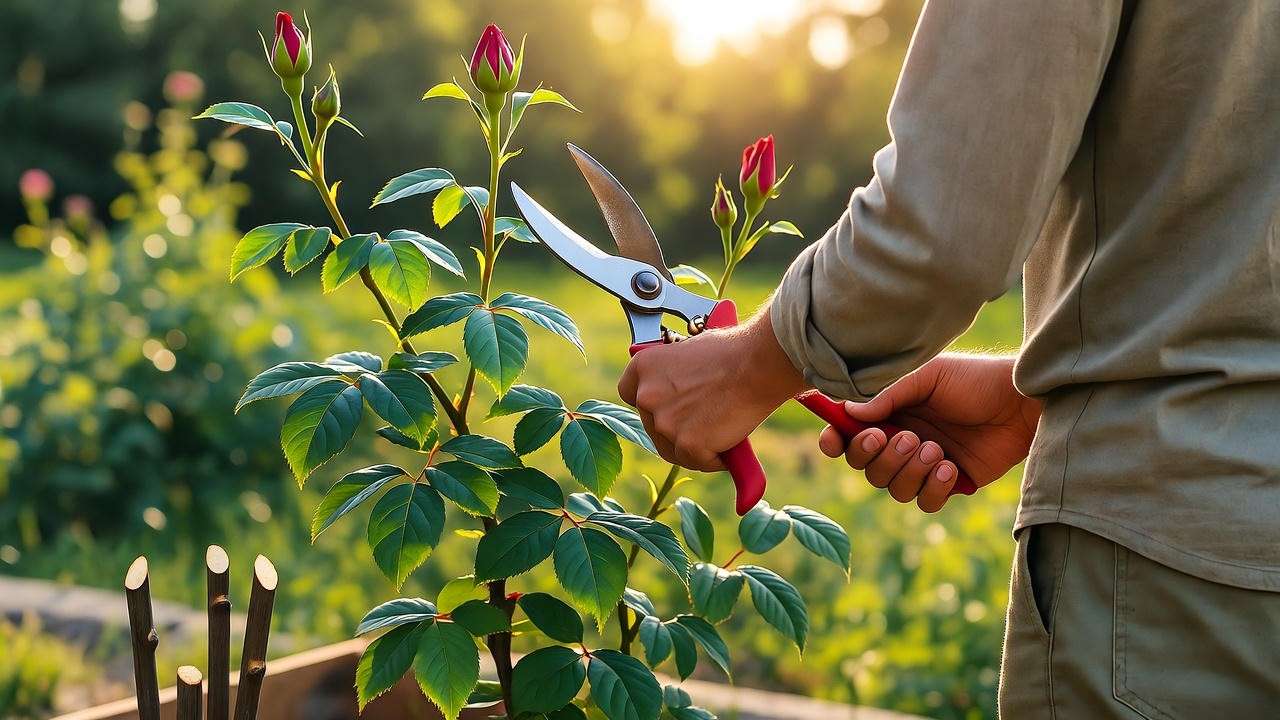
C. The Power of Resistant Varieties 🏆
The easiest way to reduce your spraying routine is to plant varieties bred for natural disease resistance.
- Consult Resources: Look for rose series and hybridizers that focus on disease resistance. Many modern shrub roses, like those in the Kordes or Canadian Explorer series, offer stunning beauty with minimal maintenance.
- Avoid Susceptible Types: Older, highly fragrant hybrid teas may be worth the effort, but understand they are often genetic magnets for Black Spot and will inevitably require a more aggressive schedule of $\text{rose plant spray}$ applications.
VII. ✅ Conclusion and Next Steps
The journey to growing magnificent, healthy roses is one defined by precision and foresight. By mastering diagnosis, choosing the appropriate $\text{rose plant spray}$ (be it a gentle Neem oil or a targeted systemic fungicide), and, most importantly, optimizing your timing and application technique, you elevate your gardening expertise to a professional level.
Remember that chemical control is just one pillar of Integrated Pest Management. Pairing a strategic spray schedule with proactive cultural practices—like ensuring great air circulation and utilizing resistant varieties—will dramatically reduce your workload and maximize your blooms.
You are now equipped with the expert-level knowledge to protect your roses all season long! I’d love to help you customize a specific spray rotation schedule for your climate, or perhaps we can look at some highly-rated disease-resistant rose varieties you might want to add to your collection. How can I help you take the next step in your rose care journey? 💖

